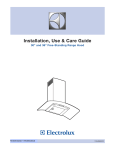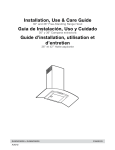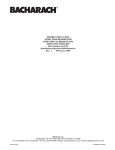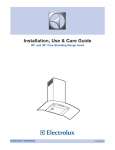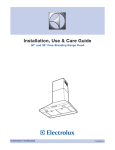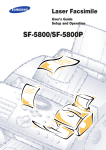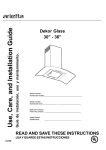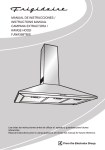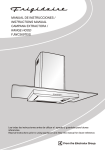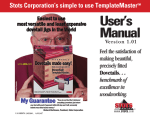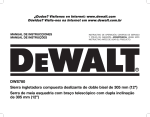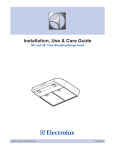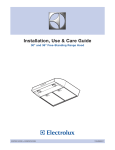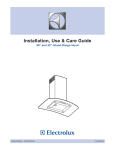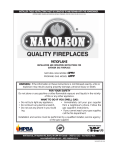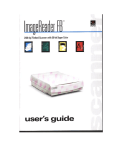Download Electrolux RH30WC60GS Use and Care Manual
Transcript
Installation, Use & Care Guide 30” and 36” Free-Standing Range Hood Guia de Instalación, Uso y Cuidado 30” y 36” Campana extractora Guide d’installation, utilisation et d’entretien 30” et 36” Hotte aspirante RH30WC60GS + RH36WC60GS OCT/10 316488522 2 Finding Information Please read and save this guide olux Thank you for choosing Electr Electrolux olux, the new premium brand in home appliances. This Use & Care Guide is part of our commitment to customer satisfaction and product quality throughout the service life of your new appliance. We view your purchase as the beginning of a relationship. To ensure our ability to continue serving you, please use this page to record important product information. Keep a rrecor ecor d for quick rrefer efer ecord eference ence Purchase date Model number NOTE Registering your product with Electrolux enhances our ability to serve you. You can register online at www.electroluxappliances.com by dropping your Product Registration Card in the mail. Serial number (see picture for location) Questions? For toll-free telephone support in the U.S. and Canada: (1-877-435-3287) For online support and Internet product information visit http://www.electroluxappliances.com Table of contents Important Safety Instructions ..................................... 3-4 Electrical & Installation rrequirements ........................... 5 Electrical requirements ......................................................... 5 IMPORTANT ............................................................................... 5 Before installing the hood .................................................. 5 List of Materials ..................................................................... 6 Parts Included with your Hood ......................................... 6 Optional Accessories ........................................................... 6 Tools/Materials required ....................................................... 6 Installing the hood ........................................................ 7-14 Installing preparation............................................................ 7 Wall framing for adequate support ................................. 7 Removing the packaging ................................................... 7 Examples of possible ducting ............................................ 8 Ductwork installation guidelines ..................................... 8 Ductwork and wiring locations ........................................ 8 Mounting the duct cover bracket ................................... 9 Ceiling ducting ...................................................................... 10 Wall ducting ............................................................................ 10 House wiring location ........................................................ 10 Install framing for hood support .................................... 10 Mounting the hood ............................................................. 11 Connecting the ductwork ............................................... 12 ©2007 Electrolux Home Products, Inc. Air deflector installation (Recirculating accessories) ................................................ 12 Making the electrical connections .................................. 13 Mounting the glass canopy ................................................ 13 Mounting the duct cover..................................................... 14 Featur es .................................................................................. 15 Features Contr ol buttons ................................................................... 16 Control Special functions ................................................................ 17 Clock programming ............................................................... 17 Grease filter saturationalarm ............................................... 17 Charcoal filter saturation alarm (Recirculating acc essories) ................................................ 17 Audible signal activation and deactivation .................. 17 Charcoal filter inclusion and exclusion (Recirculating accessories) .................................................. 17 Heat sensor............................................................................... 17 For Best results ........................................................................ 18 Car e and cleaning .............................................................. 19 Filters .......................................................................................... 19 Lights .......................................................................................... 19 Optional Charcoal Filters ..................................................... 20 Hood Surface .......................................................................... 20 Warranty Information ........................................................ 21 All rights reserved. Printed in Mexico Important Safety Instructions Important Safety Instructions Read all instructions befor e using this before appliance. Save these instructions for futur e future r efer ence. Appr oved for rresidential esidential appliances For r esidential use only Do not attempt to install or operate your appliance until you have read the safety precautions in this manual. Safety items throughout this manual are labeled with a WARNING or CAUTION based on the risk type. This symbol alerts you to situations that may cause serious body harm, death or property damage. This symbol alerts you to situations that may cause bodily injury or property damage. PLEASE READ ENTIRE INSTRUCTIONS BEFORE PROCEEDING. INSTALLATION MUST COMPLY WITH ALL LOCAL CODES. IMPORTANT: Save these Instructions for the Local Electrical Inspector’s use. INSTALLER: Please leave these Instructions with this unit for the owner. OWNER: Please retain these instructions for future reference. Safety Warning: Turn off power circuit at service panel and lock out panel, before wiring this appliance. Requirement: 120 V AC, 60 Hz. 15 or 20 A Branch Circuit 3 4 Important safety Instructions READ AND SAVE THESE INSTRUCTIONS Important safety Instructions FOR GENERAL VENTILATING USE ONLY. DO NOT USE TO EXHAUST HAZARDOUS OR EXPLOSIVE MATERIALS OR VAPORS. TO REDUCE THE RISK OF FIRE, ELECTRIC SHOCK, OR INJURY TO PERSONS, OBSERVE THE FOLLOWING: A. Use this unit only in the manner intended by the manufacturer. If you have questions, contact the manufacturer. B. Before servicing or cleaning the unit, switch power off at service panel and lock service panel disconnecting means to prevent power from being switched on accidentally. When the service disconnecting means cannot be locked, securely fasten a prominent warning device, such as a tag, to the service panel. C. Installation Work and Electrical Wiring Must Be Done By Qualified Person(s) In Accordance With All Applicable Codes & Standards, Including Fire-rated Construction. D. Sufficient air is needed for proper combustion and exhausting of gases through the flue (Chimney) of fuel burning equipment to prevent back- drafting. Follow the heating equipment manufacturers guideline and safety standards such as those published by the National Fire Protection Association (NFPA), the American Society for Heating, Refrigeration and Air Conditioning Engineers (ASHRAE), and the local code authorities. E. When cutting or drilling into wall or ceiling, do not damage electrical wiring and other hidden utilities. F. Ducted systems must always be vented to the outdoors. To reduce risk of fire and to properly exhaust air, be sure to duct air outside - do not vent exhaust air into spaces within walls, ceilings, attics, crawl spaces, or garages. TO REDUCE THE RISK OF FIRE, USE ONLY METAL DUCT WORK. Install this hood in accordance with all requirements specified. To Reduce The Risk Of Fire Or Electric Shock, Do Not Use This Hood With Any External Solid State Speed Control Device. Automatically Operated Device - To Reduce The Risk Of Injury Disconnect From Power Supply Before Servicing. This unit is equpeed with integral disconnecting switch located inside the blower housing TO REDUCE THE RISK OF A RANGE TOP GREASE FIRE. a) Never leave surface units unattended at high settings. Boilovers cause smoking and greasy spillovers that may ignite. Heat oils slowly on low or medium settings. b) Always turn hood ON when cooking at high heat or when flambeing food (I.e. Crepes Suzette, Cherries Jubilee, Peppercorn Beef Flambe’). c) Clean ventilating fans frequently. Grease should not be allowed to accumulate on fan or filter. d) Use proper pan size. Always use cookware appropriate for the size of the surface element. TO REDUCE THE RISK OF INJURY TO PERSONS, IN THE EVENT OF A RANGE TOP GREASE FIRE, OBSERVE THE FOLLOWING : a) SMOTHER FLAMES with a close-fitting lid, cookie sheet, or other metal tray, then turn off the gas burner or the electric element. BE CAREFUL TO PREVENT BURNS. If the flames do not go out immediately, EVACUATE AND CALL THE FIRE DEPARTMENT. b) NEVER PICK UP A FLAMING PAN - you may be burned. c) DO NOT USE WATER, including wet dishcloths or towels - a violent steam explosion will result. d) Use an extinguisher ONLY if: 1) You know you have a class ABC extinguisher, and you already know how to operate it. 2) The fire is small and contained in the area where it started. 3) The fire department is being called. 4) You can fight the fire with your back to an exit. OPERATION a. Always leave safety grills and filters in place. Without these components, operating blowers could catch onto hair, fingers and loose clothing. The manufacturer declines all responsibility in the event of failure to observe the instructions given here for installation, maintenance and suitable use of the product. The manufacturer further declines all responsibility for injury due to negligence and the warranty of the unit automatically expires due to improper maintenance. Important safety Instructions - Electrical & Installation requirements READ AND SAVE THESE INSTRUCTIONS Electrical & Installation requirements Electrical rrequir equir ements equirements Before installing the hood IMPOR T ANT IMPORT 1. For the most efficient air flow exhaust, use a straight run or as few elbows as possible. Observe all governing codes and ordinances. It is the customer’s responsibility: To contact a qualified electrical installer. To assure that the electrical installation is adequate and in conformance with National Electrical Code, ANSI/NFPA 70 — latest edition*, or CSA Standards C22.1-94, Canadian Electrical Code, Part 1 and C22.2 No.0-M91 - latest edition** and all local codes and ordinances. If codes permit and a separate ground wire is used, it is recommended that a qualified electrician determine that the ground path is adequate. Do not ground to a gas pipe. Check with a qualified electrician if you are not sure range hood is properly grounded. Do not have a fuse in the neutral or ground circuit. IMPOR T ANT IMPORT Save Installation Instructions for electrical inspector’s use. The range hood must be connected with copper wire only. The range hood should be connected directly to the fused disconnect (Or circuit breaker) box through metal electrical conduit. Wire sizes must conform to the requirements of the National Electrical Code ANSI/NFPA 70 — latest edition*, or CSA Standards C22.1-94, Canadian Electrical Code Part 1 and C22.2 No. 0-M91 - latest edition** and all local codes and ordinances. A U.L.- or C.S.A.-listed conduit connector must be provided at each end of the power supply conduit (at the range hood and at the junction box). Copies of the standards listed may be obtained from: * National Fire Protection Association Batterymarch Park Quincy, Massachusetts 02269 ** CSA International 8501 East Pleasant Valley Road Cleveland, Ohio 44131-5575 Vent unit to outside of building and recirculating. 2. At least two people are necessary for installation. 3. The hood is fitted with Screws and Drywall Anchors suitable for most surfaces, consult a Qualified Installer, check if they perfectly fit with your cabinet/wall. 4. Do not use flex ducting. 5. COLD WEATHER installations should have an additional backdraft damper that is already installed to minimize backward cold air flow and a nonmetallic thermal break to minimize conduction of outside temperatures as part of the ductwork. The damper should be on the cold air side of the thermal break. The break should be as close as possible to where the ducting enters the heated portion of the house. 6. Make up air: Local building codes may require the use of Make-Up Air Systems when using Ducted Ventilation Systems greater than specified CFM of air movement. The specified CFM varies from locale to locale. Consult your HVAC professional for specific requirements in your area. 5 6 List of Materials List of Materials Parts Included with your Hood t t t t t Hood canopy assembly with blower, transition. Lamp already installed. Grease filter. Glass Canopy Duct cover. t Bottom t Top t Hardware bag with: t Plastic Gasket. t Template. t Top duct cover wall support bracket (1 piece) t Use, care and installation guide t Glass bracket (2 pieces) t Wood screws (6 pieces - 3/16" x 1" 3/4) t Hood attachment anchors screws (6 pieces 1/8" x 3/8") t Assembly screws (8 pieces) Optional accessories t Re circulation KIT t Charcoal filter t Grease filter replacement Tools/Materials rrequir equir ed equired t t t t t t t t t t t t t t t t Duct tape Wire nuts Tape to mount template 8" rounded metal duct length to suit installation Gloves to protect against sharp edges Safety glasses Hammer Electric drill with 5/16" bit Pliers Measuring tape Saw, jig saw Level Knife Wire cutter Phillips (Pozidrive) # 2 screwdriver Torx # 2 screwdriver Installing the hood Installing the hood t For the most efficient air flow exhaust, use a straight run or as few elbows as possible. Vent unit to outside of building and recirculating. t On avarage 2 to 3 hours are necessary to complete installation (without considering cut to be done on wall and or on cabinet, installation of ducts , conduit and electrical connections to the mains). The hood may be installed onto a wall and vented to the outdoors, or it can be installed for recirculating operation (recirculating accessories not supplied with the hood). This hood can be installed over any electric and gas cooktop/range. It can not be installed over any pr ofessional cooktop / range. Installing pr eparation preparation t The hood is fitted with Screws and Drywall Anchors suitable for most surfaces, consult a Qualified Installer, check if they perfectly fit with your cabinet/wall. t t t t Advance planning t Determine the exact location of the vent hood. t Plan the route for venting exhaust to the outdoors. t Use the shortest and straightest duct route possible. Do not use flex ducting. Refer to “ Ductwork installation guidelines guidelines” paragraph for further informations. COLD WEATHER installations should have an additional backdraft damper that is already installed t Install a wall cap with damper or roof cap at the exterior opening. Order the wall or roof cap and to minimize backward cold air flow and a nonmetallic anytransition needed in advance. thermal break to minimize conduction of outside t Use 8" round metal ductwork only. temperatures as part of the ductwork. The damper should be on the cold air side of the thermal break. W all framing for adequate support The break should be as close as possible to t This vent hood is heavy. where the ducting enters the heated portion of ‘Adequate structure and support must be the house. provided in all types of installations. The hood must be secure to vertical studs in the wall, or to Make up air: Local building codes may require the a horizontal support. use of Make-Up Air Systems when using Ducted t The vent hood should be on site before final Ventilation Systems greater than specified CFM of framing and wall finishing. This will help to air movement. accurately locate the duct work and electrical The specified CFM varies from locale to locale. service. Consult your HVAC professional for specific t Installation will be easier if the vent hood is requirements in your area. installed before the cook-top and countertop are installed. Typical installation Min installation height from the range top to the bottom of the hood is 30" if a gas range is used Removing the packaging or 24" to 30" if an electric range is used. ecommended to be used These hoods ar e not rrecommended over indoor grills. Remove carton carefully, Wear gloves to protect against sharp edges. Remove the protective film covering the product before putting into operation. 7 8 Installing the hood Examples of possible ducting Ductwork installation guidelines Ductwork and wiring locations For safety reasons, ducting should vent directly outdoors (not into an attic, underneath the house, into the garage or into any enclosed space). Keep duct runs as short and straight as possible. Duct fittings (elbows and transitions) reduce air flow efficiency. Back to back elbows and “S“ turns give very poor delivery and are not recommended. A short straight length of duct at the inlet of the remote blower gives the best delivery. Transition to duct from the integral blower or remote duct transition as close to the downdraft as is possible. In order of preference, use 1st. 10" round duct 2nd. 8" round duct 3rd. 3-1/4" x 14" duct 4th. 7" round duct 5th. 3-1/4" x l0" duct 6th. 6" round duct t Determine the exact location of the vent hood. t Locate the template packed with the literature. t The height installation is determined by the following image. Mark the location. The use of flexible metal round duct should only be used when no other duct fitting exists. Limit use to short lengths and do not crush when making corners. 30" Gas Cooktop 24" - 30" Electric Cooktop t Installation height: 30" gas cooktop/range or 24" to 30" electric cooktop/range. t Use a level to draw a horizontal straight pencil line on the wall, which is your desired installation height. t Find the centerline of the cooktop. Use a level to draw a vertical straight pencil line on the wall. CHECK TO BE SURE THE LINE IS PERFECTL Y PERFECTLY PERPERNDICULAR. Installing the hood Mounting the duct cover bracket Ceiling ducting The duct bracket should be installed against the back wall and flush with the ceiling. This bracket will hold the telescopic duct cover in place at the top If the duct will vent straight up to the ceiling: t Use level to draw a line straight up, from the centerline on the template to the ceiling. t Measure at least 4 -3/4 ” from the back wall to the circle center of an 8-½” hole on the ceiling. . Secur e the bracket to the wall: t Align the marked centerline on the bracket with the centerline on the wall. t Mark 2 screw hole locations in the wall. t Drill 5/16" pilot holes in the marked locations. t Install wall fastener anchors. t Drive wood screws, by hand, into the fastener to allow anchors to expand. Remove the screws. t Secure the bracket to the wall with wood screws and/or fasteners. W all ducting If ductwork will vent to rear: t Use a level to draw a line straight up from the centerline on the template. t Measure at least 23 - 3/4" (the measure might vary depending on the elbow used) above the pencil line that indicates the bottom installation height, to the circle center of an 8-½” diameter duct hole (Hole may be elongated for duct elbow). House wiring location t The junction box is located on the top left side of the hood. t Wiring should enter the back wall at least 20" above the bottom of the installation height, and within 5-7/8" and 4-7/8"of the left side of the centerline. 9 10 Installing the hood Install framing for hood support If drywall is present, mark the screw hole locations. Remove the template. Cut away enough drywall to expose 2 vertical studs at the holes location indicated by the template. Install two horizontal supports at least ùé X 2é between two wall studs at the bottom and upper mounting holes installation location. room side of the studs. Use cleats behind both sides of the support to secure to wall studs. TANT IMPORT TANT IMPOR T - Framing must be capable of supporting êûû lbs. Mounting the hood WARNING: 2 people are required to lift and position the hood onto the mounting screws. Place the template on the wall along the horizontal line, make sure the template is leveled and centered with the centerline. Mark “upper” screw holes locations in the wall. IMPORTANT. Check to be sure that hole locations are leveled and correctly centered by the vertical centerline. Drive “upper” wood screws by hand. Leave ¼ “ of distance between the screw head and the wall. onto the “upper” screws. Mark “lower” wood screw holes locations in the wall using a pencil. Installing the hood Remove the hood. Drive “lower” wood screws, by hand. Remove screws. Mount the hood onto the “upper” screws. Drive and tighten the “upper” wood screws, by hand. Drive and tighten the “lower” wood screws, by hand. 11 12 Installing the hood Connecting the ductwork Air deflector installation t Install ductwork, making connections in the direction of airflow as illustrated. t Push duct over the exhaust outlet. t Wrap all duct joints and the flange connections with duct tape for an airtight seal. t Make the same connection in the wall or ceiling vent exit. Airflow Ductwork (Recir culating accessories) (Recirculating t Assemble the air deflector with the duct cover bracket with 4 assembly screws provided as shown. t Measure from the bottom of the air deflector to the bottom of the hood outlet, as shown. Duct tape over seams Hood t Cut the duct at the measured size. t Uninstall the air deflector removing the 4 assembly screws. t Slip the duct onto the bottom of the deflector. t Place the assembled deflector and duct over the exhaust outlet from the hood. t Assemble the air deflector to the duct cover bracket with 4 assembly screws provided as shown. Installing the hood Making the electrical connections Electrical Shock Hazard wiring this unit. equir ed. equired. ê2û V AC, ê5 or 2û Amp cir cuit rrequir ELECTRICAL GROUNDING INSTRUCTIONS THIS APPLIANCE IS FITTED WITH AN ELECTRICAL JUNCTION BOX WITH À WIRES, ONE OF WHICH ôGREEN/YELLOWÈSERVES TO GROUND THE APPLIANCE. TO PROTECT YOU AGAINST ELECTRIC SHOCK, THE GREEN AND YELLOW WIRE MUST BE CONNECTED TO THE GROUNDING WIRE IN YOUR HOME ELECTRICAL SYSTEM, AND IT MUST UNDER NO CIRCUMSTANCES BE CUT OR REMOVED. e to do so can rresult esult in death or electrical Failur Failure shock. Remove junction box cover and knockout on the top left side. If not already done, install ê/2” conduit connector in junction box. Run black ôliveÈ, white ôneutralÈ, and green ôearthÈ wires ôí êù AWGÈaccording to the National Electrical Code or CSA Standards and local codes and ordinances in ê/2” conduit from power supply to junction box. Connect black, white, and green wires from power supply to black, white, and green/yellow wires in junction box respectively. These connections should be done always making reference to the electrical diagram found inside the hood. Close junction box cover and reapply screws. 13 14 Installing the hood Mounting the duct cover Position the duct cover over the mounted hood. Slide the bottom of the duct onto the glass area. Position the top of the duct over the duct mounting bracket. If a telescopic duct cover is used, grab the upper part of the telescopic duct cover, pull it and place it in the duct cover mounting bracket. Secure the top of the duct with 2 assembly screws provided. Secure the bottom of the duct with 2 assembly screws provided. Remove Protective panel. Check operation of the hood. Features Features 1. 2. 3. 4. 5. 6. Blower and light controls Lamp housings Grease filter Handle Grease filter Canopy Duct cover t#PUUPN t5PQ 7. Louver holes (User for Recirculating accessories) 15 16 Controlíbuttons Controlíbuttons This hood is equipped with an electronic motor and lamp control. If the fan is at second speed and the “ speed. If the fan is at third speed and the “ ” key is pressed, the fan will be set to second speed. If the fan is at fourth speed and the “ ” button is pressed, the fan will be set to third speed. If the fan is OFF and the “ ” button is pressed, the control backlight will light up. ON/OFF light and has a timer function. In the following drawing are described the main key functions. 5.í“ 1.íLightíButton Press lamp button to turn ON the light ôLamp state previously OFFÈ. Press lamp button to turn OFF the light ôLamp state previously ONÈ. 2.íTimeríButton The default timer setting is êû minutes, and it can be adjusted between 2û minutes and êminute. After pressing the timer button, the control enters to a timer setup mode, and user can adjust the timer countdown time with the ” and “ ” buttons within 5 seconds. “ The timer can be initiated immediately pressing the timer button, after setting the timer duration or pressing the timer button twice ôdefault êû minutes settingÈ. If no action occurs within 5 seconds, the countdown will start. During the timer setup the “ ” and “ ” buttons are dedicated to the timer and no motor action will occur. Once the timer is initiated, it can be cancelled by pressing the timer button again. 3.íDisplay Shows the hood settings. 4.í“ ”íButton.íSpeedíDecr easeí/íOFF ”íButton.íSpeedíDecreaseí/íOFF This button is used to decrease the fan speed, or turn OFF the fan. The fan will turn OFF if the “ ” button is ” ”íButton.íSpeedíIncreaseí/íON ”íButton.íSpeedíIncr easeí/íON This button is used to increase the fan speed, or turn ON the fan. The fan will turn ON if the “ ” button is pressed and the hood was OFF. ” button is pressed, the fan will be set to second speed. If the fan is at second speed and the “ ” button is pressed, the fan will be set to third speed. If the fan is at third speed and the “ ” button is pressed, the fan will be set to fourth speed. If the fan is at fourth speed and the “ ” button is pressed, a beep will sound. Control buttons - Special functions Special functions Clock pr ogramming programming t The clock can be reprogrammed at any time except during an active timed function. t The clock can be displayed in a twelve hour format and valid clock times are from 1:00 to 12:59. T imer t The clock can be reprogrammed pressing the “T imer” button for 5 seconds, and after, the clock can be adjusted with the “ ” and “ ” buttons. Colon “:” will flash indicating clock programming mode. t The user can have minute increments / decrements of 1 minute, but if the user keep pressing the “ ”/ ” ” buttons for more than 1 second, the increments / decrements will be of 5 minutes. During this option the control will round to the nearest 5 minutes. t The user can finish on reprogramming the clock pressing the “ T imer imer” button. t After 1 minute of no button pressed the control will accept the programmed clock time and will add one minute to the set clock. Gr ease filter saturation alarm Grease ease Filter t After thirty fan functional hours, the display will show “ Gr Grease Filter” if the fan is active. When this icon is shown in the display, the grease filters installed are required to be washed. t To reset the grease filter saturation alarm the user must press the “ ” button for 5 seconds, after this ease filter action the icon “ Gr Grease filter” is not displayed, and the hood has the normal display operation. Char coal filter saturation alarm (Recir culating accessories) Charcoal (Recirculating t After one hundred and twenty functional hours of the fan, the display will show “ Char coal Filter Filter” if the fan is active. When this icon flashes on display, the charcoal filters installed are required to be replaced or reactivated. ” button for 5 seconds, after t To reset the charcoal filter saturation indication the user must press the “ this time the icon “ Char coal filter filter” is not displayed and the hood has the normal display operation. Audible signal activation and deactivation Light t The audible signals can be activated or deactivated pressing the “Light Light” button for 5 seconds. t If the audible signal is activated, a tone must sound and the “ Snd Snd” symbol must appear on the display for 2 seconds. t If the audible signal is deactivated, the “ Snd Snd” symbol must appear on the display for 2 seconds and no tone must sound. Char coal filter inclusion and exclusion (Recir culating accessories) Charcoal (Recirculating t The charcoal filter inclusion or exclusion can be set by pressing the “ ” and “ ” buttons at the same time for 5 seconds. t The Inclusion or exclusion of charcoal filter must be selected while the lamps and the motor are OFF. t When the charcoal filter has been excluded, the charcoal filter alarm is disabled. Heat sensor t The control is equipped with a heat sensor that will turn on the blower at second speed if excessive heat occurs (over 158° F or 70°C 70°C) surrounding the control area. t If the blower is OFF or if it is operating at first speed, the blower will be set automatically to second speed, the display shows the word " CArE CArE" to indicate that heat sensor has detected an excessive heat. t During this state, the user may raise the blower speed to third speed but can not decrease the speed. t When the temperature level on the hood drops to normal, the blower will operate in the setting defined by the user before the alarm occured. 17 18 For Best rresults esults t t t t t t t t t t t t t t Continuous use of the fan system while cooking helps keep the kitchen comfortable and less humid. It also reduces cooking odors and soiling moisture that create a frequent need for cleaning. Turn the blower on before starting to cook. Use a rear burner when browning or pan frying meat. Open a window or inside door slightly. Clean the filters and the wall behind the filters frequently. e cooking in order to establish air currents upward The blower should be turned on for a few minutes befor before through the hood. Thus when heat, smoke, moisture, grease and cooking odors are produced, they will be carried outside instead of drifting into other rooms. Use the low speeds for normal use and the higher speeds for strong odors or fumes. Drafts across the range or cooktop will cause the escape of heat, smoke, moisture, grease and cooking odors from the hood. Such drafts should be prevented in so far as possible. The best job of ventilation in the kitchen is done where the only air currents are those created by the blower itself. For Gas Cooktops, a lower blower speed should be used if: the gas flame is being distorted by the air movement. the burner continually sparks (clicks) the burner flame repeatedly blows out. Care and cleaning Care and cleaning The efficiency of the range hood system depends on the cleanliness of the intake and filters. The frequency of cleaning depends on the amount and type of cooking. t Do not use the ventilating system without the filters in place or with grease-laden filters or surfaces. To avoid risk of fire and explosion do not use flammable liquids or solvents. Always unplug or disconnect the appliance from the power supply before servicing. Be sure the entire hood (including the filters and light bulbs) has cooled and grease has solidified before attempting to clean any part of the appliance. Lights Before replacing the lamps, switch power off at service panel and lock service panel disconnecting means to prevent power from being switched on accidentally. NOTE: TTur ur n of urn offf the lights and fan. Allow the lights to cool befor e handling. If new lights do not before operate be sur e lights ar e inserted corr ectly befor e before calling service. Replace Lights t Remove the inner lamp lens cover by inserting a small flat blade screwdriver into each of the three slots and gently prying it free. NOTE: Do not remove the outer trim ring (lamp assembly). Filters The metal grease filters are made of stainless steel anodized aluminum and are long lasting. To Remove The Metal Gr ease Filters t Turn the fan and lights off. t Pull the spring release handle. t Grasp the bulb and pull it straight out. t Replace with 12 volt, 20 watt halogen bulbs with a G4 base SUITABLE FOR USE IN OPEN LUMINAIRES. Follow package dir ections, wear gloves, do not directions, touch bulb with your bar e fingers. To Replace The Metal Gr ease Filters t Reverse procedure. To Clean Filters t It is recommended that the filters be washed at least once a month; they can be washed by hand or in the dishwasher. t Drain water through edge holes and let each filter dry thoroughly before replacing it. t Replace inner cover by inserting the three retaining tabs into the three slots and pressing them firmly in place. 19 20 Care and cleaning Optional Char coal Filters Charcoal If the model is not vented to the outside, the air will be recirculated through disposable charcoal filters that help remove smoke and odors. The charcoal filters cannot be cleaned. They must be replaced. The charcoal filters are clipped inside of each metal grease filter (mounting instructions included with charcoal filters kit). The charcoal filters should be replaced every 4-6 months (depending on hood usage). NOTE: DO NOT rinse, or put charcoal filters in an automatic dishwasher. NOTE: Charcoal filters are not included with the hood. They must be ordered from your supplier. Order the needed kit specifying your hood model and width size. Char coal filter placement (Recir culating accessories) (Recirculating Fit the charcoal filter mattress on the upper side of each grease filter. Use provided springs to fix it in place. Note: When removing for replacing for a new one do not remove Fixing Springs, simply pull out and rotate outwards. Cleaning t Always use the mildest cleaner that will do the job. Use clean, soft cloths, sponges or paper towels. t Rub stainless steel finishes in the direction of the grain. Wipe area dry to avoid water marks. t After cleaning, place all parts in their proper positions before using. The cleaners recommended below indicate a type and do not constitute an endorsement. Use all products according to package directions. Hood Surface Painted Surfaces: For general care, wipe the outside of the hood with sudsy water or household cleaners such as Fantastic or Formula 409, rinse well and dry with a clean soft cloth to avoid water marks. Stainless Steel Surfaces: Wipe and dry stainless steel in the same direction as the grain. Avoid using too much pressure, which may mar the surface. To remove finger prints and give added shine, use cleaners such as Stainless Steel Magic. Do not allow any cleaning compounds to remain in contact with stainless steel for extended periods. Plastic surfaces: Wipe with a moist soapy sponge. Rinse and dry. Aluminum Mesh Filters: Clean filters in the dishwasher or by agitating in sudsy water. Ensure that there is no soil trapped in the fine mesh. Dry the filters before reinstalling them. Anodized Aluminum surfaces: Top cap is not removable. Wash top and underside with hot sudsy water. Rinse and wipe dry or apply Fantastic® or Formula 409® first to a clean sponge or paper towel and wipe clean. DO NOT USE powdered cleansers or steel wool pads. Warranty Information Your appliance is covered by a one year limited warranty. For one year from your original date of purchase, Electrolux will pay all costs for repairing or replacing any parts of this appliance that prove to be defective in materials or workmanship when such appliance is installed, used and maintained in accordance with the provided instructions. Exclusions This warranty does not cover the following: 1. Products with original serial numbers that have been removed, altered or cannot be readily determined. 2. Product that has been transferred from its original owner to another party or removed outside the USA or Canada. 3. Rust on the interior or exterior of the unit. 4. Products purchased “as-is” are not covered by this warranty. 5. Food loss due to any refrigerator or freezer failures. 6. Products used in a commercial setting. 7. Service calls which do not involve malfunction or defects in materials or workmanship, or for appliances not in ordinary household use or used other than in accordance with the provided instructions. 8. Service calls to correct the installation of your appliance or to instruct you how to use your appliance. 9. Expenses for making the appliance accessible for servicing, such as removal of trim, cupboards, shelves, etc., which are not a part of the appliance when it is shipped from the factory. 10. Service calls to repair or replace appliance light bulbs, air filters, waterfilters, other consumables, or knobs, handles, or other cosmetic parts. 11. Surcharges including, but not limited to, any after hour, weekend, or holiday service calls, tolls, ferry trip charges, or mileage expense for service calls to remote areas, including the state of Alaska. 12. Damages to the finish of appliance or home incurred during installation, including but not limited to !oors, cabinets, walls, etc. 13. Damages caused by: services performed by unauthorized service companies; use of parts other than genuine Electrolux parts or parts obtained from persons other than authorized service companies; or external causes such as abuse, misuse, inadequate power supply, accidents, fires, or acts of God. DISCLAIMER OF IMPLIED WARRANTIES; LIMITATION OF REMEDIES CUSTOMER’S SOLE AND EXCLUSIVE REMEDY UNDER THIS LIMITED WARRANTY SHALL BE PRODUCT REPAIR OR REPLACEMENT AS PROVIDED HEREIN. CLAIMS BASED ON IMPLIED WARRANTIES, INCLUDING WARRANTIES OF MERCHANTABILITY OR FITNESS FOR A PARTICULAR PURPOSE, ARE LIMITED TO ONE YEAR OR THE SHORTEST PERIOD ALLOWED BY LAW, BUT NOT LESS THAN ONE YEAR. ELECTROLUX SHALL NOT BE LIABLE FOR CONSEQUENTIAL OR INCIDENTAL DAMAGES SUCH AS PROPERTY DAMAGE AND INCIDENTAL EXPENSES RESULTING FROM ANY BREACH OF THIS WRITTEN LIMITED WARRANTY OR ANY IMPLIED WARRANTY. SOME STATES AND PROVINCES DO NOT ALLOW THE EXCLUSION OR LIMITATION OF INCIDENTAL OR CONSEQUENTIAL DAMAGES, OR LIMITATIONS ON THE DURATION OF IMPLIED WARRANTIES, SO THESE LIMITATIONS OR EXCLUSIONS MAY NOT APPLY TO YOU. THIS WRITTEN WARRANTY GIVES YOU SPECIFIC LEGAL RIGHTS. YOU MAY ALSO HAVE OTHER RIGHTS THAT VARY FROM STATE TO STATE. If You Need Service Keep your receipt, delivery slip, or some other appropriate payment record to establish the warranty period should service be required. If service is performed, it is in your best interest to obtain and keep all receipts. Service under this warranty must be obtained by contacting Electrolux at the addresses or phone numbers below. This warranty only applies in the USA and Canada. In the USA, your appliance is warranted by Electrolux Major Appliances North America, a division of Electrolux Home Products, Inc. In Canada, your appliance is warranted by Electrolux Canada Corp. Electrolux authorizes no person to change or add to any obligations under this warranty. Obligations for service and parts under this warranty must be performed by Electrolux or an authorized service company. Product features or speci cations as described or illustrated are subject to change without notice. USA 1.800.944.9044 Electrolux Major Appliances North America P.O. Box 212378 Augusta, GA 30907 Canada 1.800.265.8352 Electrolux Canada Corp. 5855 Terry Fox Way Mississauga, Ontario, Canada L5V 3E4 21 LI28OC






















